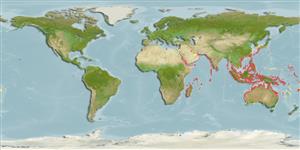Common names from other countries
Environment: milieu / climate zone / depth range / distribution range
Écologie
marin récifal; profondeur 1 - 20 m (Ref. 90102). Tropical
Indo-West Pacific: Persian Gulf and Maldives to Japan, the Philippines and Indonesia.
Taille / Poids / Âge
Maturity: Lm ? range ? - ? cm
Max length : 18.0 cm TL mâle / non sexé; (Ref. 48636)
Épines dorsales (Total): 12; Rayons mous dorsaux (Total): 25-28; Épines anales 3; Rayons mous anaux: 20 - 22.
Occur in coral reefs in pairs or several aggregations. Juveniles in estuaries (Ref. 48636). Commonly exported to Europe and America, but quite difficult to acclimate to aquarium conditions. Feed on coral polyps. Usually found on reef edge and upper slope (Ref. 6113). Oviparous (Ref. 205). Form pairs during breeding (Ref. 205).
Life cycle and mating behavior
Maturité | Reproduction | Frai | Œufs | Fécondité | Larves
Distinct pairing (Ref. 205). Monogamous mating is observed as both obligate and social (Ref. 52884).
Allen, G.R., 1985. Butterfly and angelfishes of the world. Vol. 2. 3rd edit. in English. Mergus Publishers, Melle, Germany. (Ref. 4858)
Statut dans la liste rouge de l'IUCN (Ref. 130435)
CITES (Ref. 128078)
Not Evaluated
Menace pour l'homme
Harmless
Utilisations par l'homme
Aquarium: Commercial
Outils
Articles particuliers
Télécharger en XML
Sources Internet
Estimates based on models
Preferred temperature (Ref.
115969): 25.3 - 29.2, mean 28.5 (based on 2565 cells).
Phylogenetic diversity index (Ref.
82804): PD
50 = 0.5000 [Uniqueness, from 0.5 = low to 2.0 = high].
Bayesian length-weight: a=0.02291 (0.01133 - 0.04632), b=3.00 (2.83 - 3.17), in cm Total Length, based on LWR estimates for this Genus-body shape (Ref.
93245).
Niveau trophique (Ref.
69278): 3.8 ±0.43 se; based on food items.
Résilience (Ref.
120179): Haut, temps minimum de doublement de population inférieur à 15 mois (Preliminary K or Fecundity.).
Fishing Vulnerability (Ref.
59153): Low vulnerability (10 of 100).
